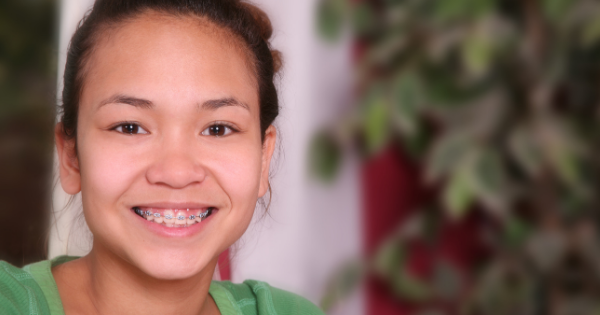So many children get braces these days and you may be wondering whether any of your children may be needing braces and when. There may be many more questions that you have about braces and it can be overwhelming. This article will cover the basics about braces for kids.

Why Do Kids Need Braces
There are many reasons why kids get braces and the best is to take your child to the dentist for regular checkups. Your dentist will be able to advise you whether he thinks your child should see an orthodontist.
Here are some cases where braces for kids are beneficial:
- loss of the baby teeth early, late or irregularly.
- finding biting or chewing difficult
- blocked out, misplaced or crowded teeth
- mouth breathing
- sucking of thumbs or fingers
- teeth and jaw that are out of proportion to the face
- when the teeth do not meet or meet abnormally
- when the jaw shifts, makes sounds, protrudes or is recessed
- when the cheek and roof of the mouth gets bitten
From What Age Can Your Child Get Braces
There is no set or recommended age to get braces for your child. Each case is different and many orthodontist problems are inherited, such as crowding of teeth, too much space between teeth, extra teeth, missing teeth or problems with jaw growth.
Other issues may develop over time due to mouth breathing, thumb sucking or poor dental hygiene.
Most orthodontic treatment begins between the ages of 9 and 14 years old. This is because at this age some adult teeth will have come out already and they will still be growing.
This orthodontist in Vancouver recommends to take your child for his first appointment at the age of 7. The reason for this is that by 7 years old your child’s adult molars and incisors will begin to show through the gumline, which will give a good idea of the future positioning of those teeth. This will enable the orthodontist to determine what your child’s bite will be.
While orthodontic treatment is unlikely to occur at the age of 7, your orthodontist will be able to give you an idea of whether there are any problems that may arise in the near future and assist you and your child with correcting any potential problems that are caused from bad habits such as thumb sucking.

What To Expect At Your Child’s First Orthodontist Appointment
Your child’s first visit to the orthodontist may involve the orthodontist taking X-rays of your child’s teeth or computer pictures. These will show the orthodontist where your child’s teeth are positioned and if there are any teeth that have not come in yet.
The orthodontist may also take a mold of your child’s teeth. A mold is taken by pushing a tray with a gooey substance onto your child’s bottom and top teeth. This gooey substance dries and leaves an impression of your child’s mouth and teeth which the orthodontist can use to determine the best treatment options.
Your child may also be asked to open and close his mouth, to open his mouth and to bite down. The orthodontist may also ask your child questions about chewing and swallowing and whether your child experiences any clicking or popping when he opens or closes his mouth.
After this assessment the orthodontist will let you know whether any treatment is needed and will come up with a treatment plan if needed.
Different Types Of Braces
The type of braces you choose will depend on the severity of your child’s case as well as other factors such as the maturity level of your child. For teens and older children Invisalign can be a great option if your child is open to wearing them regularly. However for younger children traditional braces are often the best solution.
Traditional Metal Braces
Traditional braces straighten the teeth through metal brackets that are attached to the teeth using dental glue, with archwires attached to the brackets and elastic bands. This system gently forces the teeth into their correct positions.
These types of braces are highly efficient at correcting any problems, especially with complicated cases. Treatment is fast and they are the most cost-effective treatment solution.
The downside of traditional braces is that certain types of food can get stuck in the braces, so it is best to avoid foods that get stuck. You also need to go to the orthodontist every four to six weeks to have the braces adjusted and replace the elastic bands.
Partial Braces
These are braces for children that do not require full braces. The braces and wires do not cover all the teeth.
Mini Braces
Mini braces are the same as traditional braces, however they have less metal and are smaller, which means they are more comfortable to wear and are less noticeable than traditional braces.
Self-Litigating Braces
These types of braces work along the same lines as traditional braces and mini braces with one important difference – instead of using elastic bands they use metal clips to hold the archwires in place on the brackets.
This method can straighten your child’s teeth faster than traditional braces because there is less friction involved.
Ceramic Braces
Ceramic braces have clear brackets, making them a great option for having a lesser impact on appearance. However the downside is that they are larger which means that what you gain in appearance you lose in comfort.
They are also more fragile than the metal options so they are more prone to break while playing or eating.
Invisalign
These are clear aligners that fit over your child’s teeth. They are close on invisible so they make no difference to your child’s appearance. They are also easily removed for eating and brushing teeth. They are also very strong and not easily broken. Every two weeks your child will start using a new set of aligners as his teeth start moving into the correct position.
The downside to Invisalign is that your child may refuse to wear them or forget to put them in. They need to be worn for at least 22 hours a day to be effective. This is why it is recommend that they are only used for older children that are mature enough.
This option is also only suitable for mild to moderate cases, for severe problems traditional braces for kids is a better option.
This is also a more expensive option to use.
 Kaboutjie SA Mommy Blogs by Lynne Huysamen
Kaboutjie SA Mommy Blogs by Lynne Huysamen





This is very informative. I had braces as a child and it was rather scary going to the dentist the first few times.
My mom’s wish was to get me on braces back then when I was young, I don’t know if I went to the wrong dentist who didn’t love their job or what 💔, the man didn’t help, I’m in my 20s and I still have crooked teeth, it messes with my confidence sometimes because I see the potential of what my teeth would look like if they were straight but they’re not 😂💔, I’m gonna use this for my kids one day and for my baby cousin, I’m watching his teeth closely 😌.
My daughter went to the dentist which send us to the Hospital because my daughter needs braces. But because of no medical aid she is on a waiting list for it. They said the waiting list is on 3 + Years. Then she will be out of school. She is constantly in pain with her teeth.
But we must wait.
💝
As a child I used to think braces were for fashion and I really wanted them.
I’m worried about my daughter who recently turned 18 and got her braces when she was 13 her mouth hurts she still has gaps and she was on the social service plan which gave the service free of charge now she has turned 18 and it’s been 5 years she is not happy and frankly her mouth still looks more or less the same as to when she got it